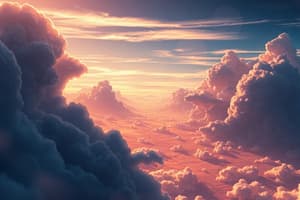Podcast
Questions and Answers
What is the lowest layer of the atmosphere?
What is the lowest layer of the atmosphere?
- Stratosphere
- Mesosphere
- Troposphere (correct)
- Thermosphere
What is the percentage of oxygen in the atmosphere?
What is the percentage of oxygen in the atmosphere?
- 1%
- 21% (correct)
- 78%
- 0.04%
What is the process by which plants release water vapor?
What is the process by which plants release water vapor?
- Transpiration (correct)
- Condensation
- Precipitation
- Evaporation
What is the long-term average atmospheric condition?
What is the long-term average atmospheric condition?
What tool is used to detect precipitation?
What tool is used to detect precipitation?
What is the outermost layer of the atmosphere?
What is the outermost layer of the atmosphere?
What is the process by which water falls to the ground?
What is the process by which water falls to the ground?
What is the percentage of carbon dioxide in the atmosphere?
What is the percentage of carbon dioxide in the atmosphere?
What is the primary reason for the creation of breezes over land masses next to large bodies of water?
What is the primary reason for the creation of breezes over land masses next to large bodies of water?
What is the main reason for the difference in strength between land and sea breezes?
What is the main reason for the difference in strength between land and sea breezes?
What happens to the air above the land during the day?
What happens to the air above the land during the day?
What is the direction of the breeze during the day?
What is the direction of the breeze during the day?
What happens to the stratification near the ground during a sea breeze?
What happens to the stratification near the ground during a sea breeze?
What happens to the air above the water at night?
What happens to the air above the water at night?
Why does friction have a greater retarding effect on land breezes?
Why does friction have a greater retarding effect on land breezes?
What is the result of the temperature difference between the land and water?
What is the result of the temperature difference between the land and water?
What is the primary means of heat transfer from the sun to the earth?
What is the primary means of heat transfer from the sun to the earth?
What is the direction of the breeze at night?
What is the direction of the breeze at night?
What happens to the energy of the light wave when it reaches an object?
What happens to the energy of the light wave when it reaches an object?
What is the result of the cooling near the ground in a land breeze?
What is the result of the cooling near the ground in a land breeze?
What is the driving force behind the creation of convection currents?
What is the driving force behind the creation of convection currents?
What happens to the air above the surface of the earth as it is heated by radiation?
What happens to the air above the surface of the earth as it is heated by radiation?
What is the main difference between a land breeze and a sea breeze?
What is the main difference between a land breeze and a sea breeze?
What is the role of light in the context of heat transfer?
What is the role of light in the context of heat transfer?
What are the two disciplines that the atmospheric sciences have been divided into?
What are the two disciplines that the atmospheric sciences have been divided into?
What is the probable composition of the Earth's original atmosphere?
What is the probable composition of the Earth's original atmosphere?
What is the likely source of the Earth's current atmosphere?
What is the likely source of the Earth's current atmosphere?
What is notable about the Earth's atmosphere in comparison to the Sun?
What is notable about the Earth's atmosphere in comparison to the Sun?
What is the prevailing belief about the noble gases in the Earth's atmosphere?
What is the prevailing belief about the noble gases in the Earth's atmosphere?
What is the term for the blanket of air around the Earth?
What is the term for the blanket of air around the Earth?
What is the term for the study of the long-term statistical properties of the atmosphere?
What is the term for the study of the long-term statistical properties of the atmosphere?
What is the term for the study of atmospheric phenomena and their time-dependent behavior?
What is the term for the study of atmospheric phenomena and their time-dependent behavior?
Flashcards are hidden until you start studying
Study Notes
Definition and Scope
- Atmospheric science is the study of the Earth's atmosphere, including its composition, properties, and processes.
- It is an interdisciplinary field that combines principles from meteorology, climatology, and atmospheric chemistry.
Atmospheric Layers
- Troposphere: lowest layer, extends up to 12 km, where weather occurs
- Stratosphere: 12-50 km, stable layer with ozone layer
- Mesosphere: 50-80 km, where meteors burn up
- Thermosphere: 80-600 km, where aurorae occur
- Exosphere: outermost layer, where atmospheric gases escape into space
Atmospheric Composition
- Nitrogen (N2): 78%
- Oxygen (O2): 21%
- Argon (Ar): 1%
- Carbon dioxide (CO2): 0.04%
- Water vapor (H2O): variable, up to 4%
- Other gases: neon, helium, methane, krypton, xenon
Atmospheric Processes
- Evaporation: liquid water becomes water vapor
- Condensation: water vapor becomes liquid water
- Transpiration: plants release water vapor
- Precipitation: water falls to the ground
- Atmospheric circulation: wind patterns and global air movements
Climate and Weather
- Weather: short-term atmospheric conditions (temperature, humidity, cloudiness, etc.)
- Climate: long-term average atmospheric conditions (temperature, precipitation, etc.)
- Climate change: long-term changes in atmospheric conditions, including global warming
Tools and Techniques
- Weather stations: measure temperature, humidity, wind, and precipitation
- Radar: uses radio waves to detect precipitation
- Satellites: observe atmospheric conditions from space
- Computer models: simulate atmospheric processes and predict weather and climate patterns
Atmospheric Science
- Interdisciplinary field combining meteorology, climatology, and atmospheric chemistry to study the Earth's atmosphere, its composition, properties, and processes.
Atmospheric Layers
- Troposphere: lowest layer, 12 km high, where weather occurs.
- Stratosphere: 12-50 km high, stable layer with ozone layer.
- Mesosphere: 50-80 km high, where meteors burn up.
- Thermosphere: 80-600 km high, where aurorae occur.
- Exosphere: outermost layer, where atmospheric gases escape into space.
Atmospheric Composition
- Nitrogen (N2): 78% of the atmosphere.
- Oxygen (O2): 21% of the atmosphere.
- Argon (Ar): 1% of the atmosphere.
- Carbon dioxide (CO2): 0.04% of the atmosphere.
- Water vapor (H2O): variable, up to 4% of the atmosphere.
- Other gases: neon, helium, methane, krypton, xenon, present in trace amounts.
Atmospheric Processes
- Evaporation: liquid water becomes water vapor, increasing atmospheric humidity.
- Condensation: water vapor becomes liquid water, forming clouds, fog, or dew.
- Transpiration: plants release water vapor into the atmosphere.
- Precipitation: water falls to the ground, including rain, snow, sleet, or hail.
- Atmospheric circulation: wind patterns and global air movements that distribute heat and moisture around the globe.
Climate and Weather
- Weather: short-term atmospheric conditions, including temperature, humidity, cloudiness, wind, and precipitation.
- Climate: long-term average atmospheric conditions, including temperature, precipitation, and weather patterns.
- Climate change: long-term changes in atmospheric conditions, including global warming and shifts in precipitation patterns.
Tools and Techniques
- Weather stations: measure temperature, humidity, wind, and precipitation on the ground.
- Radar: uses radio waves to detect precipitation, tracking storms and monitoring weather patterns.
- Satellites: observe atmospheric conditions from space, monitoring weather patterns, climate, and atmospheric phenomena.
- Computer models: simulate atmospheric processes, predicting weather and climate patterns, and forecasting future changes.
Convection Currents
- Convection currents occur when a low-pressure region is created by heating, resulting in the movement of material.
- Example: Breezes over land masses next to large bodies of water.
Heat Capacity and Temperature Differences
- Water has a larger heat capacity than land, taking longer to change its temperature.
- During the day, air above the water is cooler than over the land, creating a low-pressure area over the land.
- At night, water cools off more slowly than the land, creating a low-pressure area over the water.
Sea Breezes
- Temperature differences between land and sea lead to the development of local winds called sea breezes.
- When the Sun heats the land, the air above it expands and rises, being replaced by cooler air from above the sea surface.
Atmospheric Science
- The atmospheric sciences comprise related and overlapping disciplines, including meteorology and climatology.
- The blanket of air around the Earth is called the atmosphere.
Composition of the Atmosphere
- The original atmosphere was likely different from the current one, possibly similar to the composition of the solar nebula.
- The current atmosphere is oxidizing, whereas the original atmosphere was reducing.
- The atmosphere is deficient in noble gases, such as helium, neon, xenon, and krypton.
Land and Sea Breezes
- Sea breezes are caused by heating near the ground, making the stratification weaker and encouraging vertical motion.
- Land breezes are produced by cooling near the ground, producing strong stratification and inhibiting vertical motion.
- Nighttime cooling produces a shallower change in temperature, resulting in a weaker flow.
Radiation
- Radiation refers to the transfer of heat through light, such as from the Sun to the Earth.
- This energy can be converted back into heat when it reaches the Earth's surface.
Studying That Suits You
Use AI to generate personalized quizzes and flashcards to suit your learning preferences.




